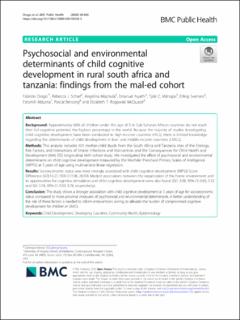| dc.contributor.author | Drago, Fabrizio | |
| dc.contributor.author | Scharf, Rebecca J. | |
| dc.contributor.author | Maphula, Angelina | |
| dc.contributor.author | Nyathi, Emanuel | |
| dc.contributor.author | Mahopo, Tjale C. | |
| dc.contributor.author | Svensen, Erling | |
| dc.contributor.author | Mduma, Estomih | |
| dc.contributor.author | Bessong, Pascal | |
| dc.contributor.author | Rogawski McQuade, Elizabeth T. | |
| dc.date.accessioned | 2021-04-28T08:08:46Z | |
| dc.date.available | 2021-04-28T08:08:46Z | |
| dc.date.created | 2021-02-02T11:49:47Z | |
| dc.date.issued | 2020 | |
| dc.Published | BMC Public Health. 2020, 20 (1), . | |
| dc.identifier.issn | 1471-2458 | |
| dc.identifier.uri | https://hdl.handle.net/11250/2740066 | |
| dc.description.abstract | Background
Approximately 66% of children under the age of 5 in Sub-Saharan African countries do not reach their full cognitive potential, the highest percentage in the world. Because the majority of studies investigating child cognitive development have been conducted in high-income countries (HICs), there is limited knowledge regarding the determinants of child development in low- and middle-income countries (LMICs).
Methods
This analysis includes 401 mother-child dyads from the South Africa and Tanzania sites of the Etiology, Risk Factors, and Interactions of Enteric Infections and Malnutrition and the Consequences for Child Health and Development (MAL-ED) longitudinal birth cohort study. We investigated the effect of psychosocial and environmental determinants on child cognitive development measured by the Wechsler Preschool Primary Scales of Intelligence (WPPSI) at 5 years of age using multivariable linear regression.
Results
Socioeconomic status was most strongly associated with child cognitive development (WPSSI Score Difference (SD):14.27, 95% CI:1.96, 26.59). Modest associations between the organization of the home environment and its opportunities for cognitive stimulation and child cognitive development were also found (SD: 3.08, 95% CI: 0.65, 5.52 and SD: 3.18, 95% CI: 0.59, 5.76, respectively).
Conclusion
This study shows a stronger association with child cognitive development at 5 years of age for socioeconomic status compared to more proximal measures of psychosocial and environmental determinants. A better understanding of the role of these factors is needed to inform interventions aiming to alleviate the burden of compromised cognitive development for children in LMICs. | en_US |
| dc.language.iso | eng | en_US |
| dc.publisher | BioMed Central (BMC) | en_US |
| dc.rights | Navngivelse 4.0 Internasjonal | * |
| dc.rights.uri | http://creativecommons.org/licenses/by/4.0/deed.no | * |
| dc.title | Psychosocial and environmental determinants of child cognitive development in rural south africa and tanzania: findings from the mal-ed cohort | en_US |
| dc.type | Journal article | en_US |
| dc.type | Peer reviewed | en_US |
| dc.description.version | publishedVersion | en_US |
| dc.rights.holder | © The Author(s). 2020 | en_US |
| dc.source.articlenumber | 505 | en_US |
| cristin.ispublished | true | |
| cristin.fulltext | original | |
| cristin.qualitycode | 1 | |
| dc.identifier.doi | 10.1186/s12889-020-08598-5 | |
| dc.identifier.cristin | 1885805 | |
| dc.source.journal | BMC Public Health | en_US |
| dc.source.40 | 20 | |
| dc.source.14 | 1 | |
| dc.identifier.citation | BMC Public Health. 2020, 20, 505 (2020). | en_US |
| dc.source.volume | 20 | en_US |

